Literature Review: Physical Activity Across Different Age Groups
VerifiedAdded on 2022/12/23
|9
|2364
|1
Literature Review
AI Summary
This literature review examines the significance of physical activity across various age groups, from preschool-aged children to older adults. It defines physical activity and its importance for overall health, discussing specific exercise recommendations, merits, and potential side effects for each age group. The review highlights the benefits of physical activity for children and adolescents, including improved concentration and cardiovascular health, while also addressing the risks of over-exercising. For adults, the review emphasizes the importance of maintaining a healthy BMI and mental well-being through regular exercise. Finally, it discusses the benefits of physical activity for older adults, such as improved balance and mental health, while cautioning against overexertion. The report concludes that physical activity is crucial for all ages, but expert guidance and appropriate precautions are necessary to maximize benefits and minimize risks. The review references multiple books and journals to support its findings.
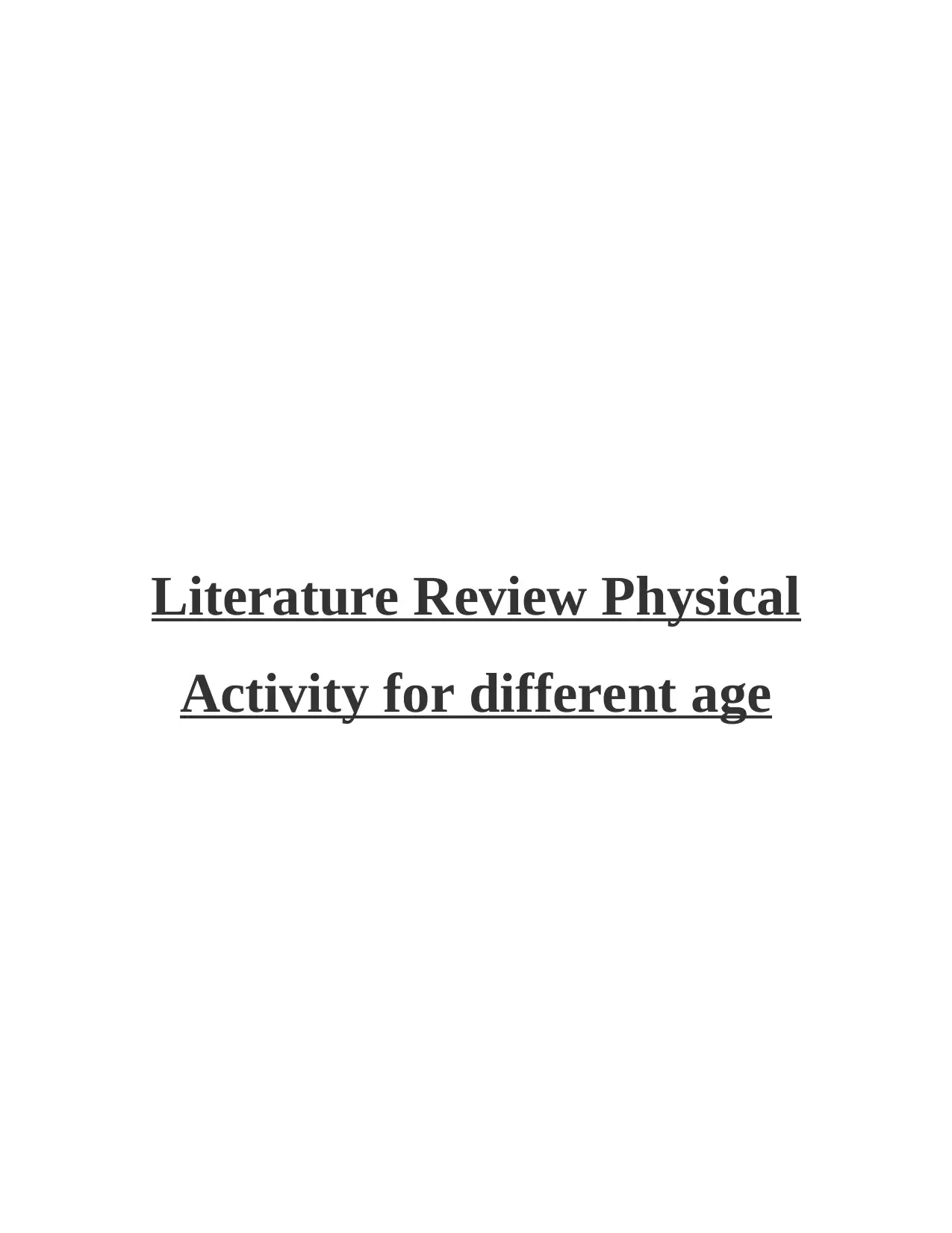
Literature Review Physical
Activity for different age
Activity for different age
Paraphrase This Document
Need a fresh take? Get an instant paraphrase of this document with our AI Paraphraser
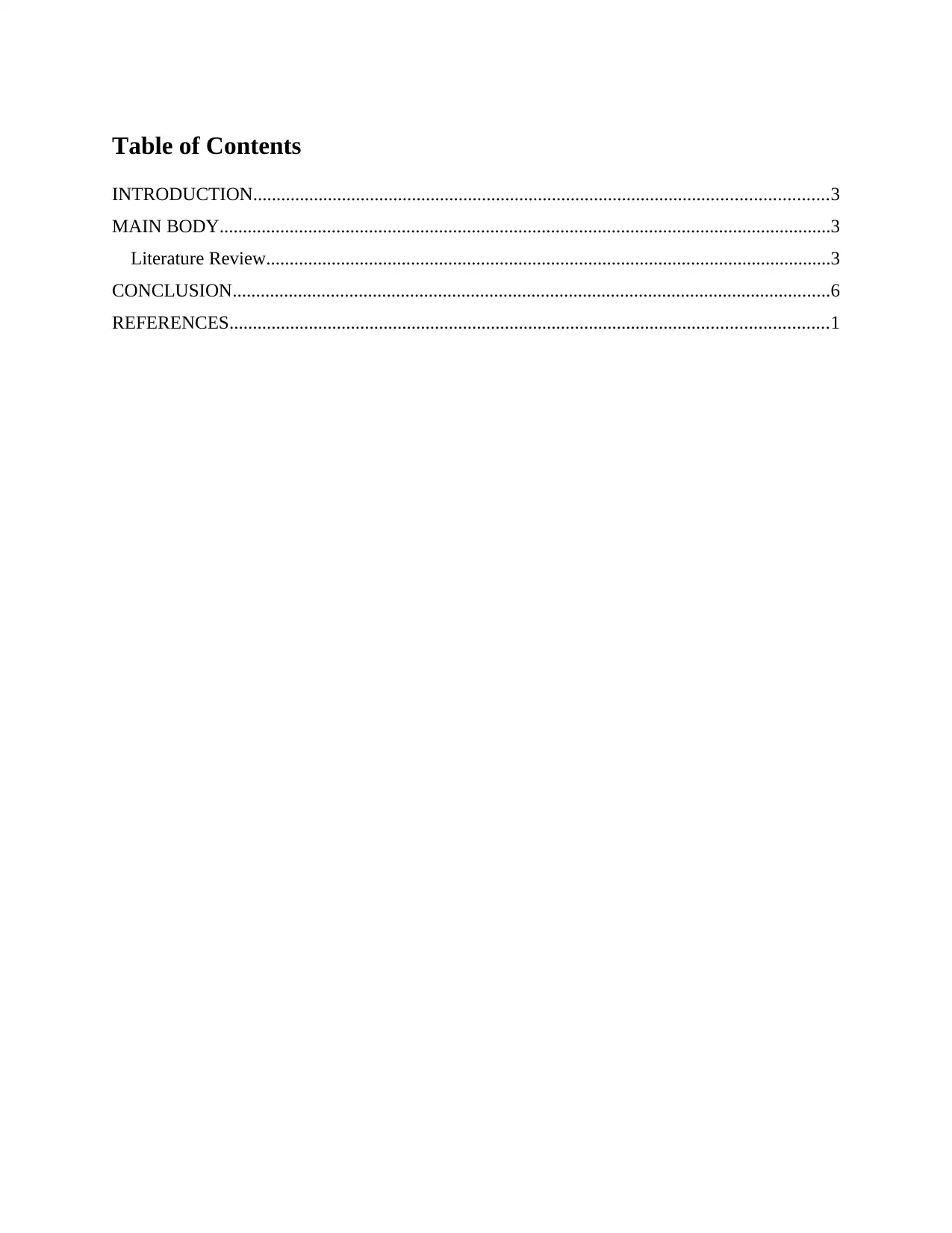
Table of Contents
INTRODUCTION...........................................................................................................................3
MAIN BODY...................................................................................................................................3
Literature Review.........................................................................................................................3
CONCLUSION................................................................................................................................6
REFERENCES................................................................................................................................1
INTRODUCTION...........................................................................................................................3
MAIN BODY...................................................................................................................................3
Literature Review.........................................................................................................................3
CONCLUSION................................................................................................................................6
REFERENCES................................................................................................................................1
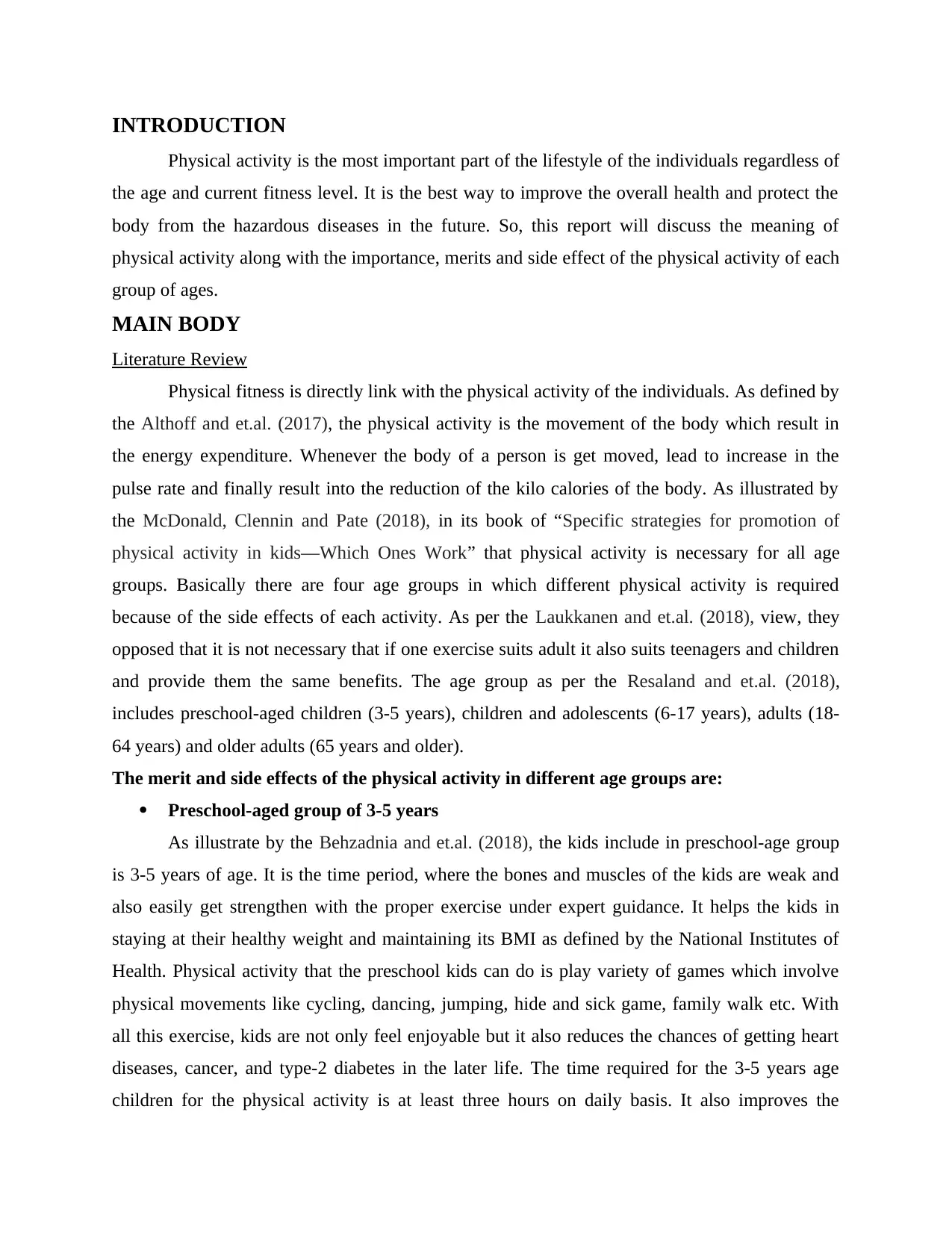
INTRODUCTION
Physical activity is the most important part of the lifestyle of the individuals regardless of
the age and current fitness level. It is the best way to improve the overall health and protect the
body from the hazardous diseases in the future. So, this report will discuss the meaning of
physical activity along with the importance, merits and side effect of the physical activity of each
group of ages.
MAIN BODY
Literature Review
Physical fitness is directly link with the physical activity of the individuals. As defined by
the Althoff and et.al. (2017), the physical activity is the movement of the body which result in
the energy expenditure. Whenever the body of a person is get moved, lead to increase in the
pulse rate and finally result into the reduction of the kilo calories of the body. As illustrated by
the McDonald, Clennin and Pate (2018), in its book of “Specific strategies for promotion of
physical activity in kids—Which Ones Work” that physical activity is necessary for all age
groups. Basically there are four age groups in which different physical activity is required
because of the side effects of each activity. As per the Laukkanen and et.al. (2018), view, they
opposed that it is not necessary that if one exercise suits adult it also suits teenagers and children
and provide them the same benefits. The age group as per the Resaland and et.al. (2018),
includes preschool-aged children (3-5 years), children and adolescents (6-17 years), adults (18-
64 years) and older adults (65 years and older).
The merit and side effects of the physical activity in different age groups are:
Preschool-aged group of 3-5 years
As illustrate by the Behzadnia and et.al. (2018), the kids include in preschool-age group
is 3-5 years of age. It is the time period, where the bones and muscles of the kids are weak and
also easily get strengthen with the proper exercise under expert guidance. It helps the kids in
staying at their healthy weight and maintaining its BMI as defined by the National Institutes of
Health. Physical activity that the preschool kids can do is play variety of games which involve
physical movements like cycling, dancing, jumping, hide and sick game, family walk etc. With
all this exercise, kids are not only feel enjoyable but it also reduces the chances of getting heart
diseases, cancer, and type-2 diabetes in the later life. The time required for the 3-5 years age
children for the physical activity is at least three hours on daily basis. It also improves the
Physical activity is the most important part of the lifestyle of the individuals regardless of
the age and current fitness level. It is the best way to improve the overall health and protect the
body from the hazardous diseases in the future. So, this report will discuss the meaning of
physical activity along with the importance, merits and side effect of the physical activity of each
group of ages.
MAIN BODY
Literature Review
Physical fitness is directly link with the physical activity of the individuals. As defined by
the Althoff and et.al. (2017), the physical activity is the movement of the body which result in
the energy expenditure. Whenever the body of a person is get moved, lead to increase in the
pulse rate and finally result into the reduction of the kilo calories of the body. As illustrated by
the McDonald, Clennin and Pate (2018), in its book of “Specific strategies for promotion of
physical activity in kids—Which Ones Work” that physical activity is necessary for all age
groups. Basically there are four age groups in which different physical activity is required
because of the side effects of each activity. As per the Laukkanen and et.al. (2018), view, they
opposed that it is not necessary that if one exercise suits adult it also suits teenagers and children
and provide them the same benefits. The age group as per the Resaland and et.al. (2018),
includes preschool-aged children (3-5 years), children and adolescents (6-17 years), adults (18-
64 years) and older adults (65 years and older).
The merit and side effects of the physical activity in different age groups are:
Preschool-aged group of 3-5 years
As illustrate by the Behzadnia and et.al. (2018), the kids include in preschool-age group
is 3-5 years of age. It is the time period, where the bones and muscles of the kids are weak and
also easily get strengthen with the proper exercise under expert guidance. It helps the kids in
staying at their healthy weight and maintaining its BMI as defined by the National Institutes of
Health. Physical activity that the preschool kids can do is play variety of games which involve
physical movements like cycling, dancing, jumping, hide and sick game, family walk etc. With
all this exercise, kids are not only feel enjoyable but it also reduces the chances of getting heart
diseases, cancer, and type-2 diabetes in the later life. The time required for the 3-5 years age
children for the physical activity is at least three hours on daily basis. It also improves the
⊘ This is a preview!⊘
Do you want full access?
Subscribe today to unlock all pages.

Trusted by 1+ million students worldwide
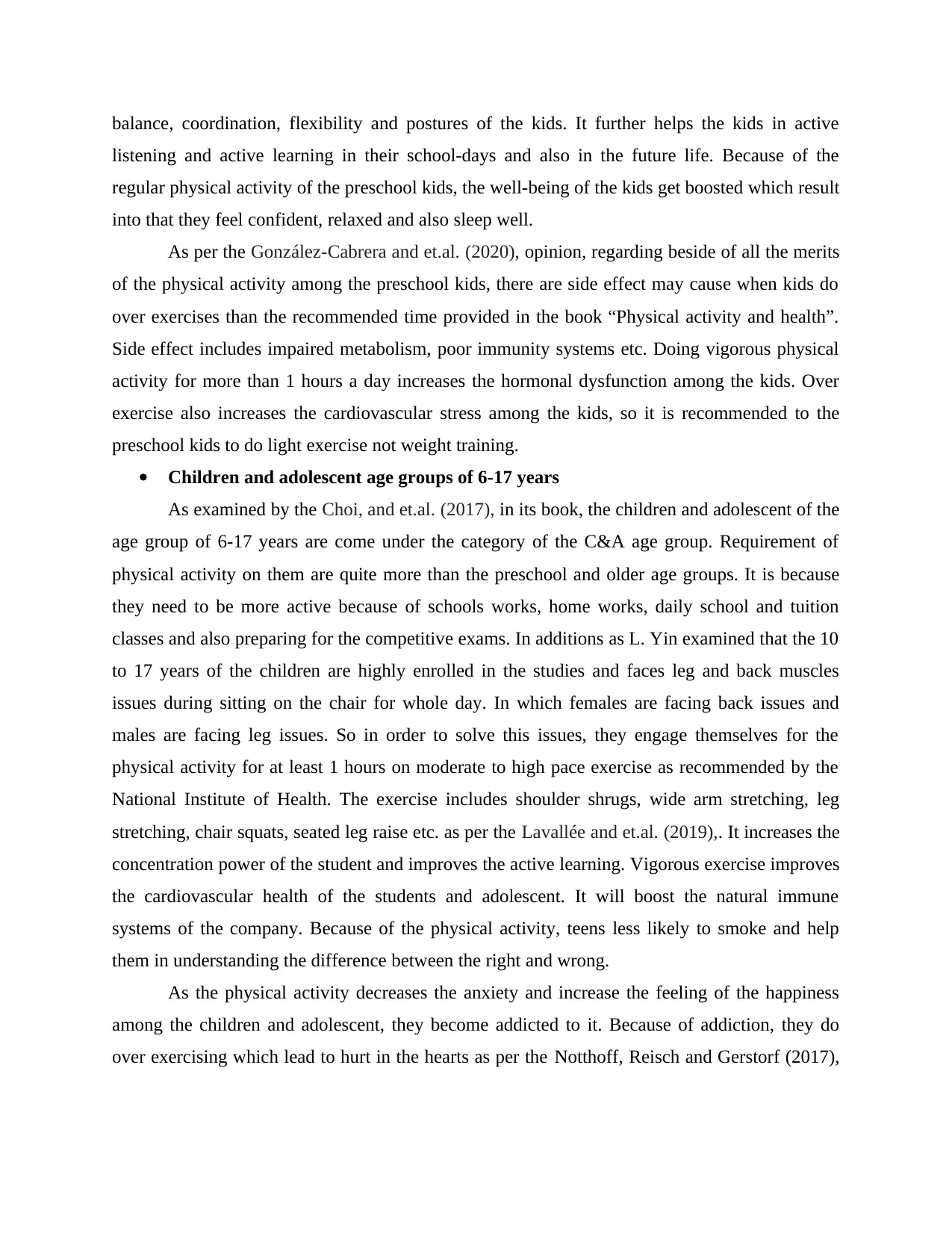
balance, coordination, flexibility and postures of the kids. It further helps the kids in active
listening and active learning in their school-days and also in the future life. Because of the
regular physical activity of the preschool kids, the well-being of the kids get boosted which result
into that they feel confident, relaxed and also sleep well.
As per the González-Cabrera and et.al. (2020), opinion, regarding beside of all the merits
of the physical activity among the preschool kids, there are side effect may cause when kids do
over exercises than the recommended time provided in the book “Physical activity and health”.
Side effect includes impaired metabolism, poor immunity systems etc. Doing vigorous physical
activity for more than 1 hours a day increases the hormonal dysfunction among the kids. Over
exercise also increases the cardiovascular stress among the kids, so it is recommended to the
preschool kids to do light exercise not weight training.
Children and adolescent age groups of 6-17 years
As examined by the Choi, and et.al. (2017), in its book, the children and adolescent of the
age group of 6-17 years are come under the category of the C&A age group. Requirement of
physical activity on them are quite more than the preschool and older age groups. It is because
they need to be more active because of schools works, home works, daily school and tuition
classes and also preparing for the competitive exams. In additions as L. Yin examined that the 10
to 17 years of the children are highly enrolled in the studies and faces leg and back muscles
issues during sitting on the chair for whole day. In which females are facing back issues and
males are facing leg issues. So in order to solve this issues, they engage themselves for the
physical activity for at least 1 hours on moderate to high pace exercise as recommended by the
National Institute of Health. The exercise includes shoulder shrugs, wide arm stretching, leg
stretching, chair squats, seated leg raise etc. as per the Lavallée and et.al. (2019),. It increases the
concentration power of the student and improves the active learning. Vigorous exercise improves
the cardiovascular health of the students and adolescent. It will boost the natural immune
systems of the company. Because of the physical activity, teens less likely to smoke and help
them in understanding the difference between the right and wrong.
As the physical activity decreases the anxiety and increase the feeling of the happiness
among the children and adolescent, they become addicted to it. Because of addiction, they do
over exercising which lead to hurt in the hearts as per the Notthoff, Reisch and Gerstorf (2017),
listening and active learning in their school-days and also in the future life. Because of the
regular physical activity of the preschool kids, the well-being of the kids get boosted which result
into that they feel confident, relaxed and also sleep well.
As per the González-Cabrera and et.al. (2020), opinion, regarding beside of all the merits
of the physical activity among the preschool kids, there are side effect may cause when kids do
over exercises than the recommended time provided in the book “Physical activity and health”.
Side effect includes impaired metabolism, poor immunity systems etc. Doing vigorous physical
activity for more than 1 hours a day increases the hormonal dysfunction among the kids. Over
exercise also increases the cardiovascular stress among the kids, so it is recommended to the
preschool kids to do light exercise not weight training.
Children and adolescent age groups of 6-17 years
As examined by the Choi, and et.al. (2017), in its book, the children and adolescent of the
age group of 6-17 years are come under the category of the C&A age group. Requirement of
physical activity on them are quite more than the preschool and older age groups. It is because
they need to be more active because of schools works, home works, daily school and tuition
classes and also preparing for the competitive exams. In additions as L. Yin examined that the 10
to 17 years of the children are highly enrolled in the studies and faces leg and back muscles
issues during sitting on the chair for whole day. In which females are facing back issues and
males are facing leg issues. So in order to solve this issues, they engage themselves for the
physical activity for at least 1 hours on moderate to high pace exercise as recommended by the
National Institute of Health. The exercise includes shoulder shrugs, wide arm stretching, leg
stretching, chair squats, seated leg raise etc. as per the Lavallée and et.al. (2019),. It increases the
concentration power of the student and improves the active learning. Vigorous exercise improves
the cardiovascular health of the students and adolescent. It will boost the natural immune
systems of the company. Because of the physical activity, teens less likely to smoke and help
them in understanding the difference between the right and wrong.
As the physical activity decreases the anxiety and increase the feeling of the happiness
among the children and adolescent, they become addicted to it. Because of addiction, they do
over exercising which lead to hurt in the hearts as per the Notthoff, Reisch and Gerstorf (2017),
Paraphrase This Document
Need a fresh take? Get an instant paraphrase of this document with our AI Paraphraser

views. Sometimes exercising lead that the children isolate themselves from the society. And in
order to deal with the isolations they start eating more sugary products and cause diabetes.
Adults age group of 18-64 years
As per the opinion of the Larsen and et.al. (2019), it is important for the adults to do daily
physical exercise for at least 150 minutes of moderate pace aerobic activity as recommended by
the NIH. The physical activity helps them in maintaining the body BMI. As they are working out
and need to complete the daily targets of the company which require the concentration power
and flexible posture to sit whole day. So it is important for them to do regular exercise to feel
happy and decrease the feeling of depression. The Rogers and et.al. (2018), also illustrate, that
the physical activity helps the adults in their weight loss which is get increased by continuous
siting in the offices. Dieting reduced the caloric intake and reduces metabolic rate, while on the
other hand physical activity increases metabolic rate and leads to faster weight loss. Physical
exercise helps in building bone density at the younger age and prevent the adults from the
osteoporosis diseases later in life. The physical activity state that it increases the energy level of
the adults suffering from the diseases such as cancer, HIV etc.
The Muellmann and et.al. (2017), criticize the views that dieting is not helps in the
weight loss but in actual the weight loss is the 70% dieting and the 30% exercise. Only
exercising will cause serious problem to the adults body and also affect their mind. Side effect of
high intensity exercise for more than 150 minutes includes hormonal imbalance lead to increase
in hunger, decrease in the athletic performance, poor immunity, excessive fatigue in the body
systems etc.
Older adults age group of plus 64 years
As the Ricardo and et.al. (2020), illustrate that as the time passes the bones and muscles
of the old age people get shrink and their bone density decreases. Old age people with age above
64 years are less active as they are retired and have less work at home as well which lead to low
physical movement. So they need to do daily exercise for 1 hour at moderate intensity such as
walking, running, cycling etc. It will help in preventing them from the common diseases such as
heart diseases, cancer, diabetes etc. As the Craike and et.al. (2018), study shows that the
exercises releases endorphins in the body which reduces the stress and improves the mental
health of the older adults. Endorphins is the hormone which help in feeling good to the people.
Generally all the older adults are deals with the insomnia and disturbed sleep patterns, so it is
order to deal with the isolations they start eating more sugary products and cause diabetes.
Adults age group of 18-64 years
As per the opinion of the Larsen and et.al. (2019), it is important for the adults to do daily
physical exercise for at least 150 minutes of moderate pace aerobic activity as recommended by
the NIH. The physical activity helps them in maintaining the body BMI. As they are working out
and need to complete the daily targets of the company which require the concentration power
and flexible posture to sit whole day. So it is important for them to do regular exercise to feel
happy and decrease the feeling of depression. The Rogers and et.al. (2018), also illustrate, that
the physical activity helps the adults in their weight loss which is get increased by continuous
siting in the offices. Dieting reduced the caloric intake and reduces metabolic rate, while on the
other hand physical activity increases metabolic rate and leads to faster weight loss. Physical
exercise helps in building bone density at the younger age and prevent the adults from the
osteoporosis diseases later in life. The physical activity state that it increases the energy level of
the adults suffering from the diseases such as cancer, HIV etc.
The Muellmann and et.al. (2017), criticize the views that dieting is not helps in the
weight loss but in actual the weight loss is the 70% dieting and the 30% exercise. Only
exercising will cause serious problem to the adults body and also affect their mind. Side effect of
high intensity exercise for more than 150 minutes includes hormonal imbalance lead to increase
in hunger, decrease in the athletic performance, poor immunity, excessive fatigue in the body
systems etc.
Older adults age group of plus 64 years
As the Ricardo and et.al. (2020), illustrate that as the time passes the bones and muscles
of the old age people get shrink and their bone density decreases. Old age people with age above
64 years are less active as they are retired and have less work at home as well which lead to low
physical movement. So they need to do daily exercise for 1 hour at moderate intensity such as
walking, running, cycling etc. It will help in preventing them from the common diseases such as
heart diseases, cancer, diabetes etc. As the Craike and et.al. (2018), study shows that the
exercises releases endorphins in the body which reduces the stress and improves the mental
health of the older adults. Endorphins is the hormone which help in feeling good to the people.
Generally all the older adults are deals with the insomnia and disturbed sleep patterns, so it is

beneficial for them to do regular exercise. Because they dependent on their children for the basic
needs fulfilment, there is a risk of falls feeling among them. So exercise improves strength and
flexibility which further improve the balance and coordination among the old age people.
As per the Piercy and et.al. (2018), views, Sometime overexercising lead to dangerous
emotional and mental health issue such as heart attack, depressions, increase in pulse rate etc. If
is because when the older adults do regular exercise and unable to take proper sleep of 7 to 8
hours at night. So it is important to exercise but with proper precautions and under the
supervision of the expert.
CONCLUSION
The report concludes the literature review of physical activity for different groups. The
report concludes that the physical activity is important for all aged groups but it must be done
under the expert supervision. The report concludes the physical exercise, time period, intensity
pace of the exercise of each aged group. This report also concludes the impact of the
overexercising on the all age group with the diseases the caught up. The report also concludes
that how exercising help the student, working people, kids and old age people in achieving their
goals.
needs fulfilment, there is a risk of falls feeling among them. So exercise improves strength and
flexibility which further improve the balance and coordination among the old age people.
As per the Piercy and et.al. (2018), views, Sometime overexercising lead to dangerous
emotional and mental health issue such as heart attack, depressions, increase in pulse rate etc. If
is because when the older adults do regular exercise and unable to take proper sleep of 7 to 8
hours at night. So it is important to exercise but with proper precautions and under the
supervision of the expert.
CONCLUSION
The report concludes the literature review of physical activity for different groups. The
report concludes that the physical activity is important for all aged groups but it must be done
under the expert supervision. The report concludes the physical exercise, time period, intensity
pace of the exercise of each aged group. This report also concludes the impact of the
overexercising on the all age group with the diseases the caught up. The report also concludes
that how exercising help the student, working people, kids and old age people in achieving their
goals.
⊘ This is a preview!⊘
Do you want full access?
Subscribe today to unlock all pages.

Trusted by 1+ million students worldwide
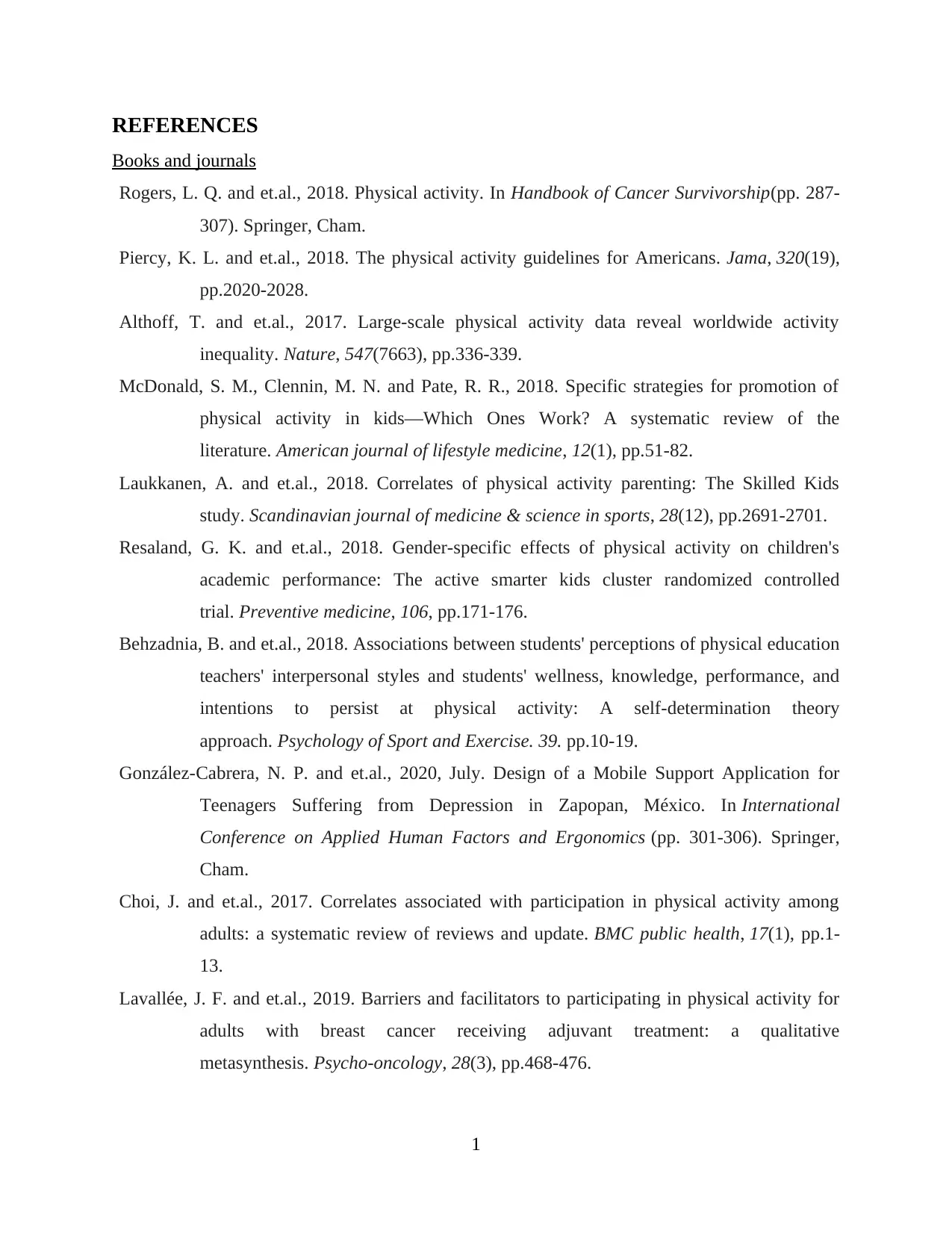
REFERENCES
Books and journals
Rogers, L. Q. and et.al., 2018. Physical activity. In Handbook of Cancer Survivorship(pp. 287-
307). Springer, Cham.
Piercy, K. L. and et.al., 2018. The physical activity guidelines for Americans. Jama, 320(19),
pp.2020-2028.
Althoff, T. and et.al., 2017. Large-scale physical activity data reveal worldwide activity
inequality. Nature, 547(7663), pp.336-339.
McDonald, S. M., Clennin, M. N. and Pate, R. R., 2018. Specific strategies for promotion of
physical activity in kids—Which Ones Work? A systematic review of the
literature. American journal of lifestyle medicine, 12(1), pp.51-82.
Laukkanen, A. and et.al., 2018. Correlates of physical activity parenting: The Skilled Kids
study. Scandinavian journal of medicine & science in sports, 28(12), pp.2691-2701.
Resaland, G. K. and et.al., 2018. Gender-specific effects of physical activity on children's
academic performance: The active smarter kids cluster randomized controlled
trial. Preventive medicine, 106, pp.171-176.
Behzadnia, B. and et.al., 2018. Associations between students' perceptions of physical education
teachers' interpersonal styles and students' wellness, knowledge, performance, and
intentions to persist at physical activity: A self-determination theory
approach. Psychology of Sport and Exercise. 39. pp.10-19.
González-Cabrera, N. P. and et.al., 2020, July. Design of a Mobile Support Application for
Teenagers Suffering from Depression in Zapopan, México. In International
Conference on Applied Human Factors and Ergonomics (pp. 301-306). Springer,
Cham.
Choi, J. and et.al., 2017. Correlates associated with participation in physical activity among
adults: a systematic review of reviews and update. BMC public health, 17(1), pp.1-
13.
Lavallée, J. F. and et.al., 2019. Barriers and facilitators to participating in physical activity for
adults with breast cancer receiving adjuvant treatment: a qualitative
metasynthesis. Psycho‐oncology, 28(3), pp.468-476.
1
Books and journals
Rogers, L. Q. and et.al., 2018. Physical activity. In Handbook of Cancer Survivorship(pp. 287-
307). Springer, Cham.
Piercy, K. L. and et.al., 2018. The physical activity guidelines for Americans. Jama, 320(19),
pp.2020-2028.
Althoff, T. and et.al., 2017. Large-scale physical activity data reveal worldwide activity
inequality. Nature, 547(7663), pp.336-339.
McDonald, S. M., Clennin, M. N. and Pate, R. R., 2018. Specific strategies for promotion of
physical activity in kids—Which Ones Work? A systematic review of the
literature. American journal of lifestyle medicine, 12(1), pp.51-82.
Laukkanen, A. and et.al., 2018. Correlates of physical activity parenting: The Skilled Kids
study. Scandinavian journal of medicine & science in sports, 28(12), pp.2691-2701.
Resaland, G. K. and et.al., 2018. Gender-specific effects of physical activity on children's
academic performance: The active smarter kids cluster randomized controlled
trial. Preventive medicine, 106, pp.171-176.
Behzadnia, B. and et.al., 2018. Associations between students' perceptions of physical education
teachers' interpersonal styles and students' wellness, knowledge, performance, and
intentions to persist at physical activity: A self-determination theory
approach. Psychology of Sport and Exercise. 39. pp.10-19.
González-Cabrera, N. P. and et.al., 2020, July. Design of a Mobile Support Application for
Teenagers Suffering from Depression in Zapopan, México. In International
Conference on Applied Human Factors and Ergonomics (pp. 301-306). Springer,
Cham.
Choi, J. and et.al., 2017. Correlates associated with participation in physical activity among
adults: a systematic review of reviews and update. BMC public health, 17(1), pp.1-
13.
Lavallée, J. F. and et.al., 2019. Barriers and facilitators to participating in physical activity for
adults with breast cancer receiving adjuvant treatment: a qualitative
metasynthesis. Psycho‐oncology, 28(3), pp.468-476.
1
Paraphrase This Document
Need a fresh take? Get an instant paraphrase of this document with our AI Paraphraser
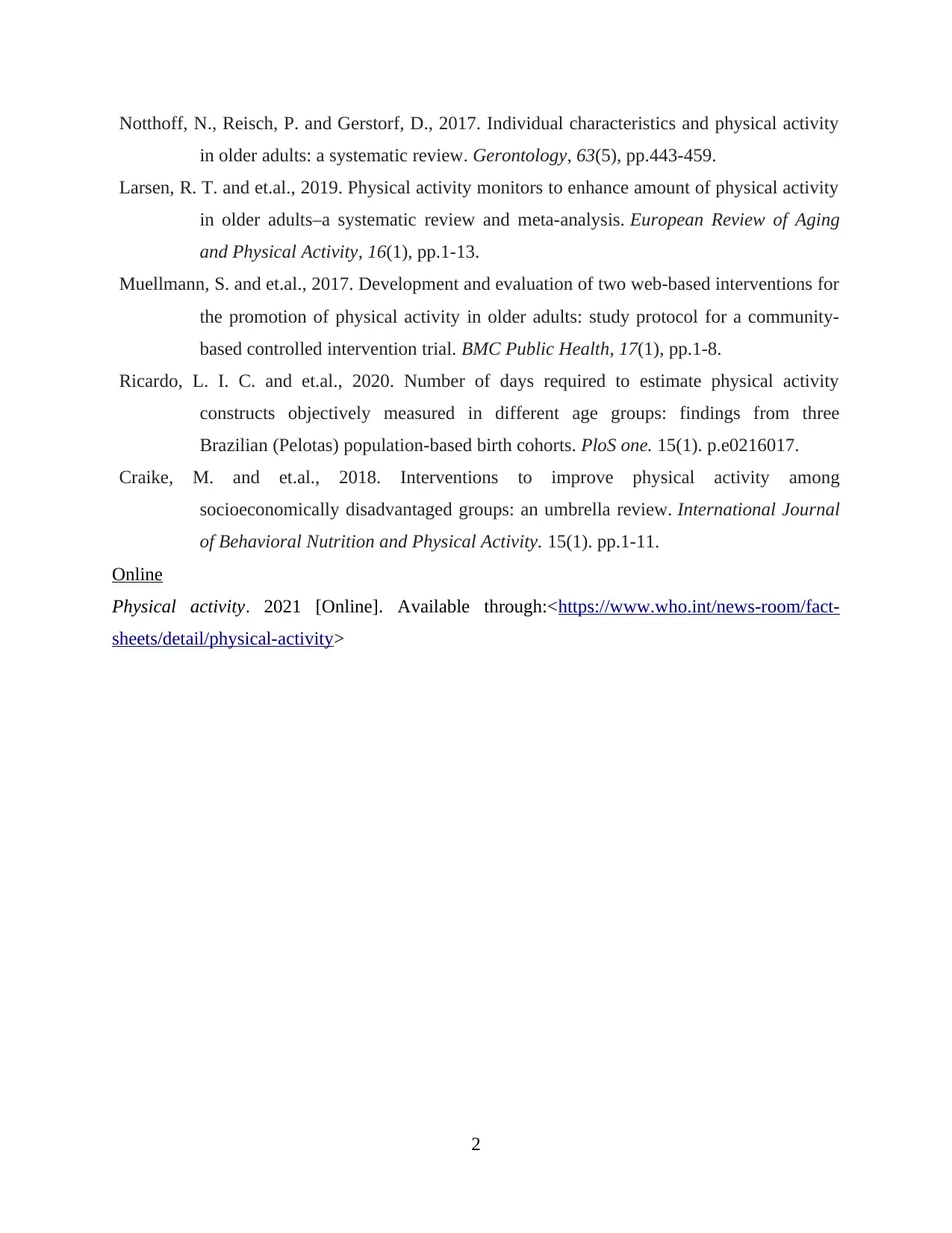
Notthoff, N., Reisch, P. and Gerstorf, D., 2017. Individual characteristics and physical activity
in older adults: a systematic review. Gerontology, 63(5), pp.443-459.
Larsen, R. T. and et.al., 2019. Physical activity monitors to enhance amount of physical activity
in older adults–a systematic review and meta-analysis. European Review of Aging
and Physical Activity, 16(1), pp.1-13.
Muellmann, S. and et.al., 2017. Development and evaluation of two web-based interventions for
the promotion of physical activity in older adults: study protocol for a community-
based controlled intervention trial. BMC Public Health, 17(1), pp.1-8.
Ricardo, L. I. C. and et.al., 2020. Number of days required to estimate physical activity
constructs objectively measured in different age groups: findings from three
Brazilian (Pelotas) population-based birth cohorts. PloS one. 15(1). p.e0216017.
Craike, M. and et.al., 2018. Interventions to improve physical activity among
socioeconomically disadvantaged groups: an umbrella review. International Journal
of Behavioral Nutrition and Physical Activity. 15(1). pp.1-11.
Online
Physical activity. 2021 [Online]. Available through:<https://www.who.int/news-room/fact-
sheets/detail/physical-activity>
2
in older adults: a systematic review. Gerontology, 63(5), pp.443-459.
Larsen, R. T. and et.al., 2019. Physical activity monitors to enhance amount of physical activity
in older adults–a systematic review and meta-analysis. European Review of Aging
and Physical Activity, 16(1), pp.1-13.
Muellmann, S. and et.al., 2017. Development and evaluation of two web-based interventions for
the promotion of physical activity in older adults: study protocol for a community-
based controlled intervention trial. BMC Public Health, 17(1), pp.1-8.
Ricardo, L. I. C. and et.al., 2020. Number of days required to estimate physical activity
constructs objectively measured in different age groups: findings from three
Brazilian (Pelotas) population-based birth cohorts. PloS one. 15(1). p.e0216017.
Craike, M. and et.al., 2018. Interventions to improve physical activity among
socioeconomically disadvantaged groups: an umbrella review. International Journal
of Behavioral Nutrition and Physical Activity. 15(1). pp.1-11.
Online
Physical activity. 2021 [Online]. Available through:<https://www.who.int/news-room/fact-
sheets/detail/physical-activity>
2

3
⊘ This is a preview!⊘
Do you want full access?
Subscribe today to unlock all pages.

Trusted by 1+ million students worldwide
1 out of 9
Related Documents
Your All-in-One AI-Powered Toolkit for Academic Success.
+13062052269
info@desklib.com
Available 24*7 on WhatsApp / Email
![[object Object]](/_next/static/media/star-bottom.7253800d.svg)
Unlock your academic potential
Copyright © 2020–2025 A2Z Services. All Rights Reserved. Developed and managed by ZUCOL.





